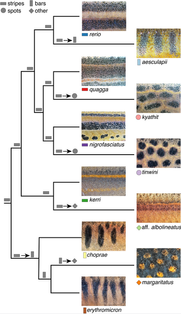
David Parichy
Pratt-Ivy Foundation Distinguished Professor of Morphogensis

Research
Vertebrates have undergone spectacular morphological diversification and a key contributor to adaptive evolution in this group is the neural crest, a transient population of embryonic cells that gives gives to much of the craniofacial skeleton, teeth, neurons, glia, pigment cells and other derivatives. Among neural crest derived traits, adult pigmentation has emerged as a particularly exciting model in which to study mechanisms at hierarchical levels ranging from genes to cells, and individuals to populations and clades. In our lab, we take an integrative approach to understand the evolution of pigment pattern especially in Danio fishes. Key advantages to this group are tractability for genetic and genomic analyses, the ability to watch morphogenesis at single cell resolution even as the phenotypes are developing, and the terrific diversity of patterns, including stripes, spots, bars and more. Although much of our work focuses on developmental genetic mechanisms, it is inspired by evolutionary questions and so we do not hesitate to tackle questions in the field, or address behavioral mechanisms in the lab. Beyond this system, additional work aims to understand the development and diversification of scales, pigment pattern diversification in Corydoras catfish, and the evolution of novel cell types in clownfish and other fishes. We also maintain long standing interests in amphibians.
Our group is well-equipped for functional and other studies, with several lab-dedicated microscopes including super-resolution laser confocal imaging systems, custom designed animal facilities, and next generation sequencing capabilities including our own Illumina sequencer. Students and postdocs joining the lab often work on projects that are extensions of past and present research. But we are always open to new and interesting questions, and we encourage trainees to think “outside the box” in developing their own programs.
Click a figure below for more information about recent publications.



